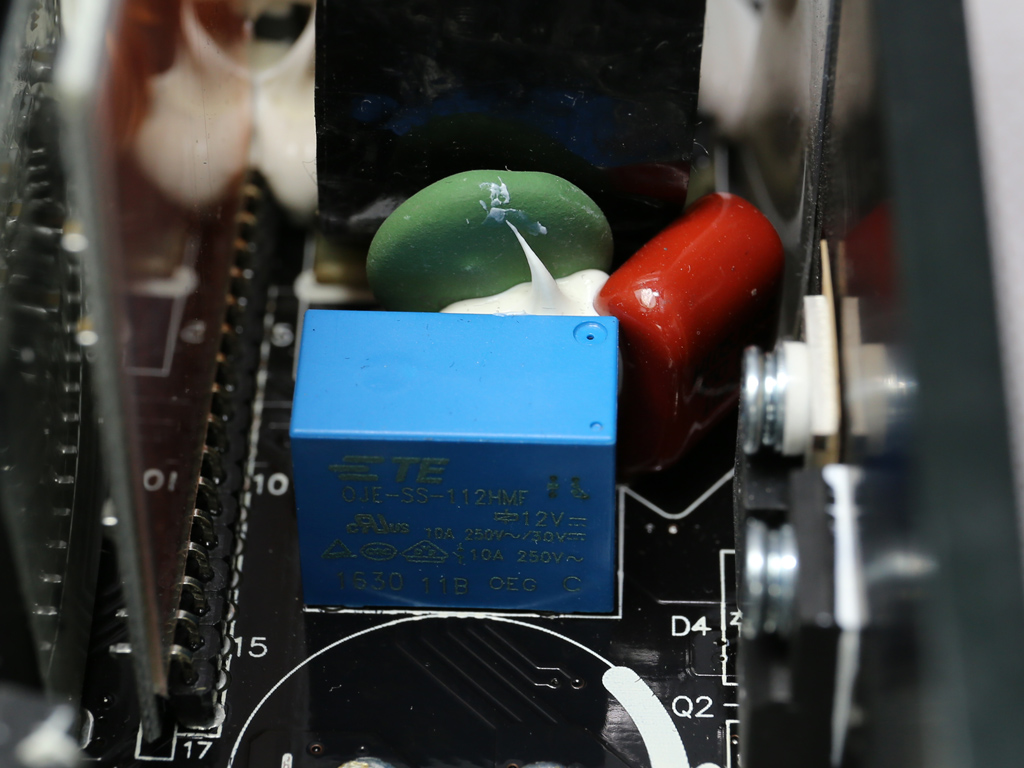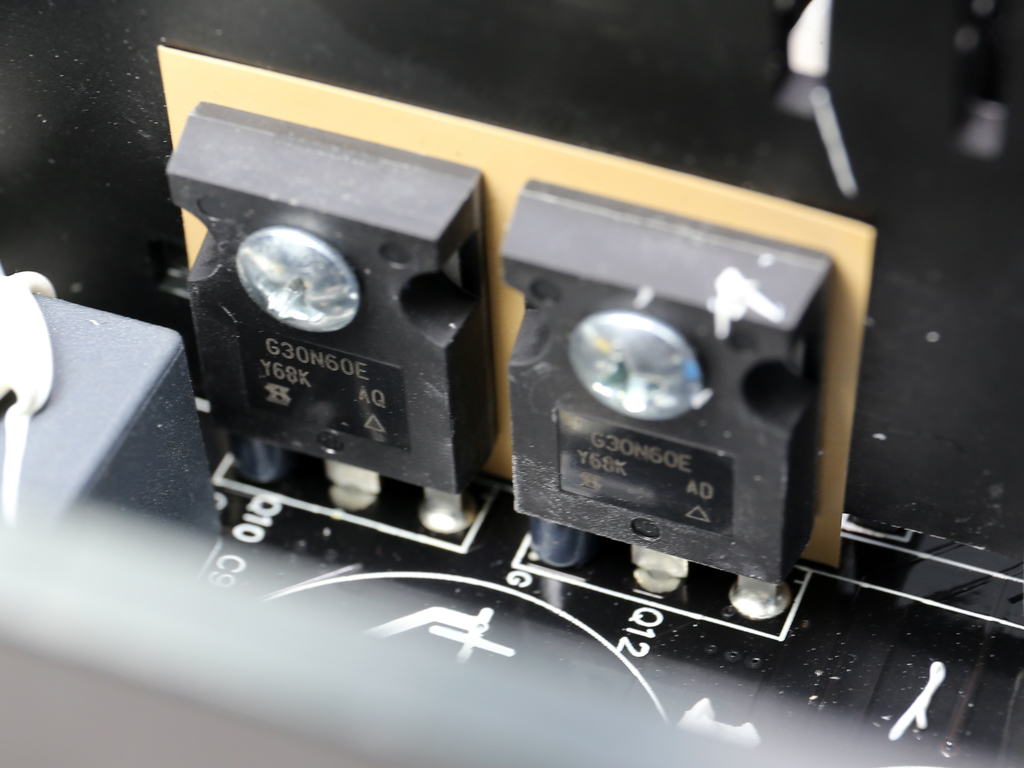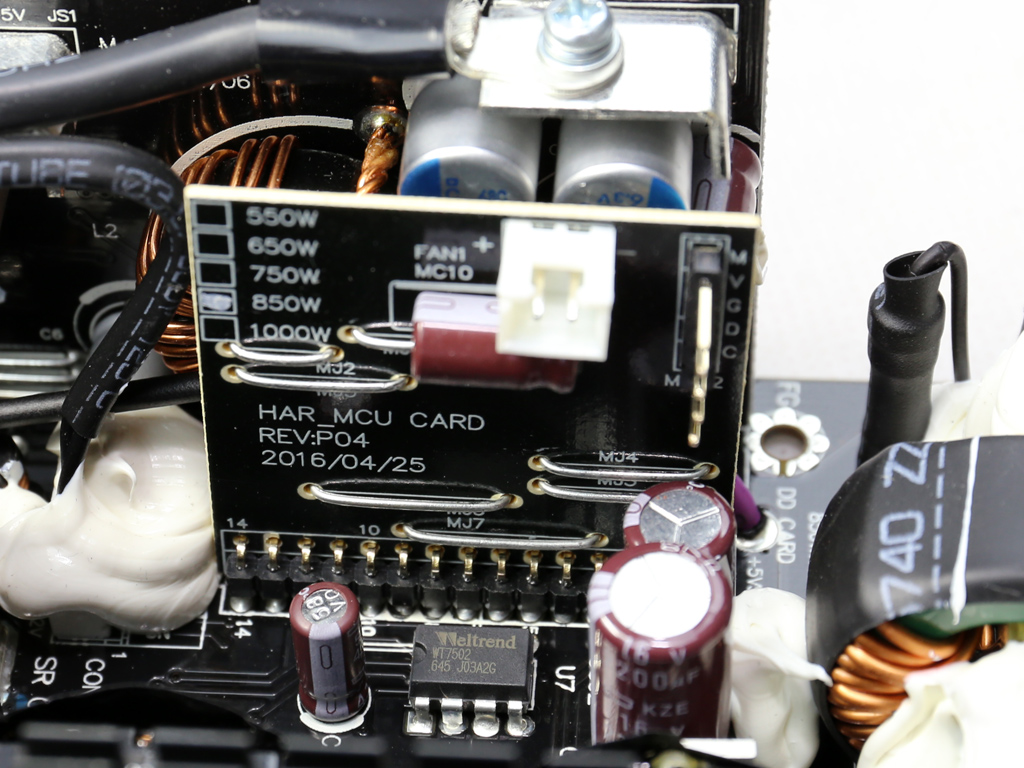Corsair HX850 PSU Review
Why you can trust Tom's Hardware
Teardown & Component Analysis
Parts Description
Before proceeding with this page we strongly encourage you to a look at our PSUs 101 article, which provides valuable information about PSUs and their operation, allowing you to better understand the components we're about to discuss. Our main tools for disassembling PSUs are a Thermaltronics soldering and rework station and a Hakko FR-300 desoldering gun. Finally, for the identification of tiny parts we use an Andonstar HDMI digital microscope.
| General Data | |
|---|---|
| Manufacturer (OEM) | CWT |
| Platform Model | - |
| Primary Side | |
| Transient Filter | 6x Y caps, 2x X caps, 2x CM chokes, 1x MOV |
| Inrush Protection | NTC Thermistor & Diode |
| Bridge Rectifier(s) | 2x Vishay LVB2560 (600V, 25A @ 105°C) |
| APFC MOSFETs | 2x Infineon IPZ60R125P6 (650V, 19A @ 100°C, 0.113Ω) |
| APFC Boost Diode | 1x CREE C3D10060A (600V, 10A @ 153°C) |
| Hold-up Cap(s) | 2x Chemi-Con (400V, 470uF each or 940uF combined, 2000h @ 105°C, KMW) |
| Main Switchers | 2x Vishay SIHG30N60E (650V, 18A @ 100°C, 0.125Ω) |
| APFC Controller | Infineon ICE3PCS01G - CM03X |
| LLC Resonant Controller | Infineon ICE2HS01G |
| Topology | Primary side: Half-Bridge & LLC Resonant Controller Secondary side: Synchronous Rectification & DC-DC converters |
| Secondary Side | |
| +12V MOSFETs | 8x Infineon BSC014N04LS (40V, 100A @ 100°C, 1.4mΩ) |
| 5V & 3.3V | DC-DC Converters: 6x Ubiq QM3004D (30V, 40A @ 100°C, 8.5mΩ) PWM Controller: 1x APW7159C |
| Filtering Capacitors | Electrolytics: Nippon Chemi-Con (1-5000 @ 105°C, KZE), Nippon Chemi-Con (4-10,000 @ 105°C, KY) Polymers: Nippon Chemi-Con, FPCAP |
| Supervisor IC | Weltrend WT7502 (OVP, UVP, PG, SCP), 2x Weltrend WT7518 (OCP, PG, SCP) |
| Fan Model | NR135P (135mm, 12V, 0.22A, Fluid Dynamic Bearing) |
| Fan Controller | Microchip PIC16F1503 |
| 5VSB Circuit | |
| Mosfet / Rectifier | 1x M03N65D / 1x MBRU2045CT SBR (45V, 20A @ 125°C) |
| Standby PWM Controller | On-Bright OB5269CP |
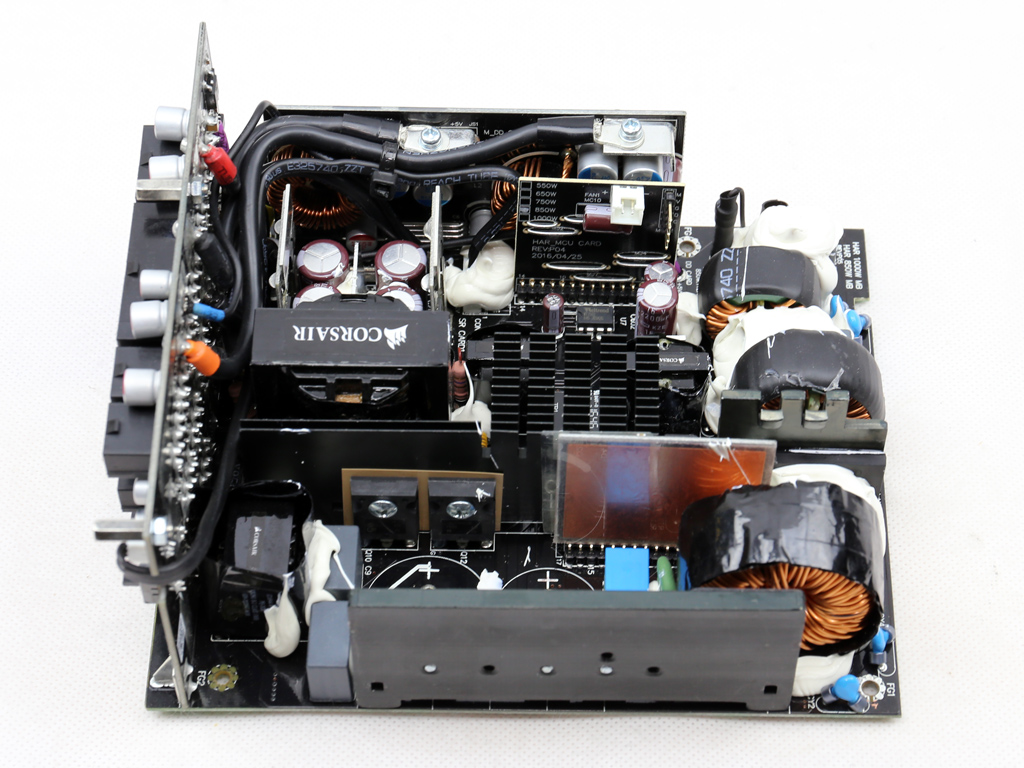
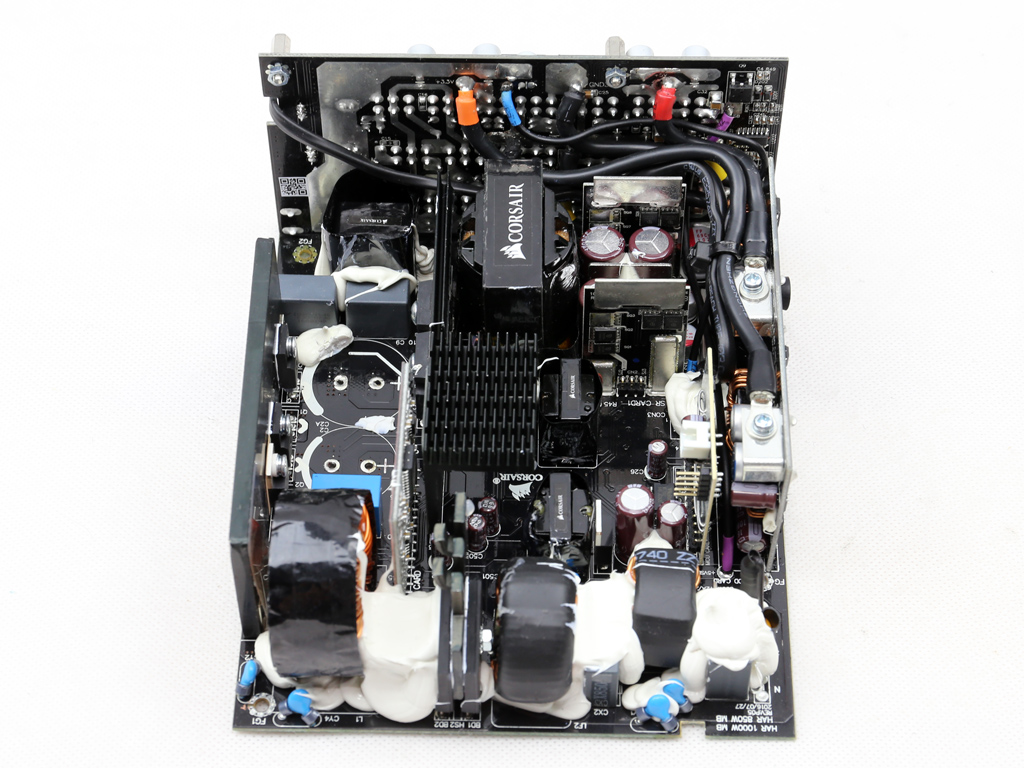
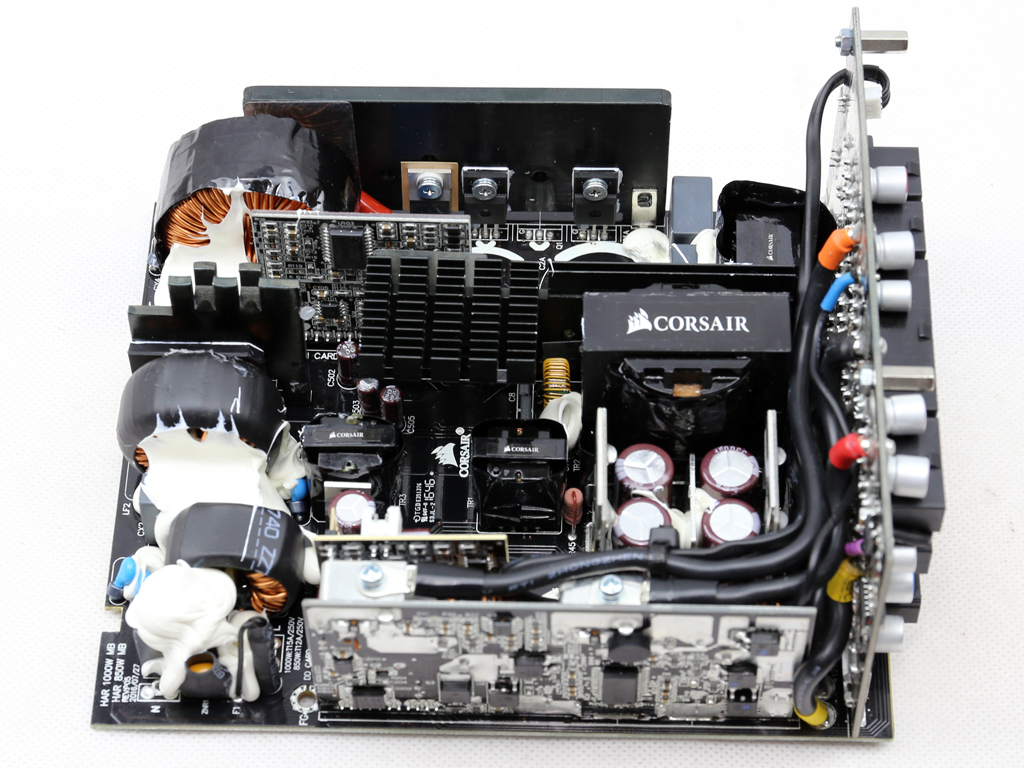
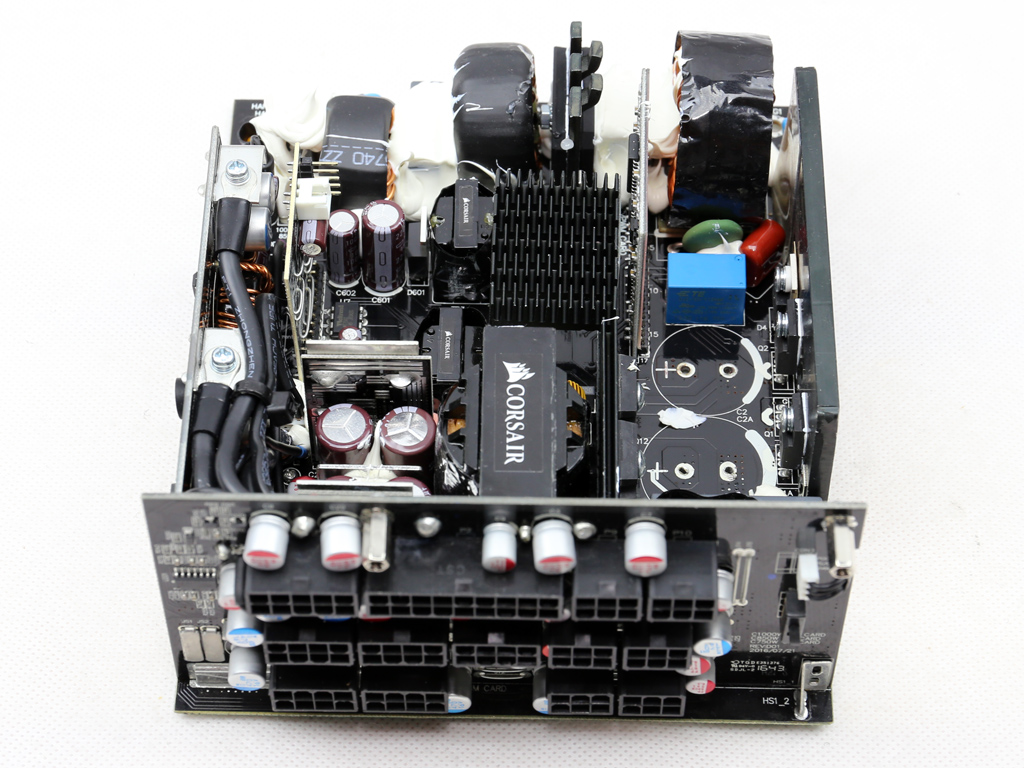

This platform is identical to the one used in Corsair's HX1000. On the primary side, we find a half-bridge topology supported by an LLC resonant converter for increased efficiency levels. On the secondary side, FETs regulate the +12V rail and a couple of voltage regulation modules (VRMs) generate the minor rails. This is a typical high-end CWT platform, so there are no heat sinks on the secondary side. Meanwhile, a number of bus bars help cool the +12V FETs. Although that might seem strange from a PSU featuring semi-passive operation and such a long warranty, the design appears to be bulletproof, even under high ambient temperatures. Thanks to a high efficiency rating and heat-resistant +12V FETs, it isn't necessary to use sinks or a super-strong fan.
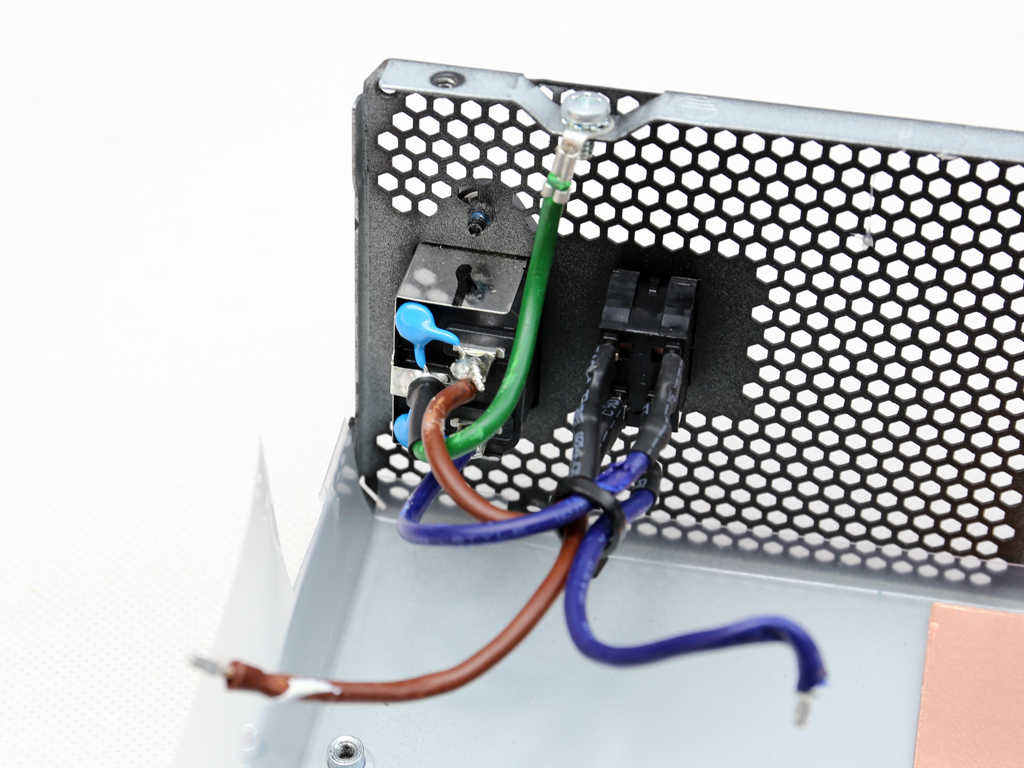

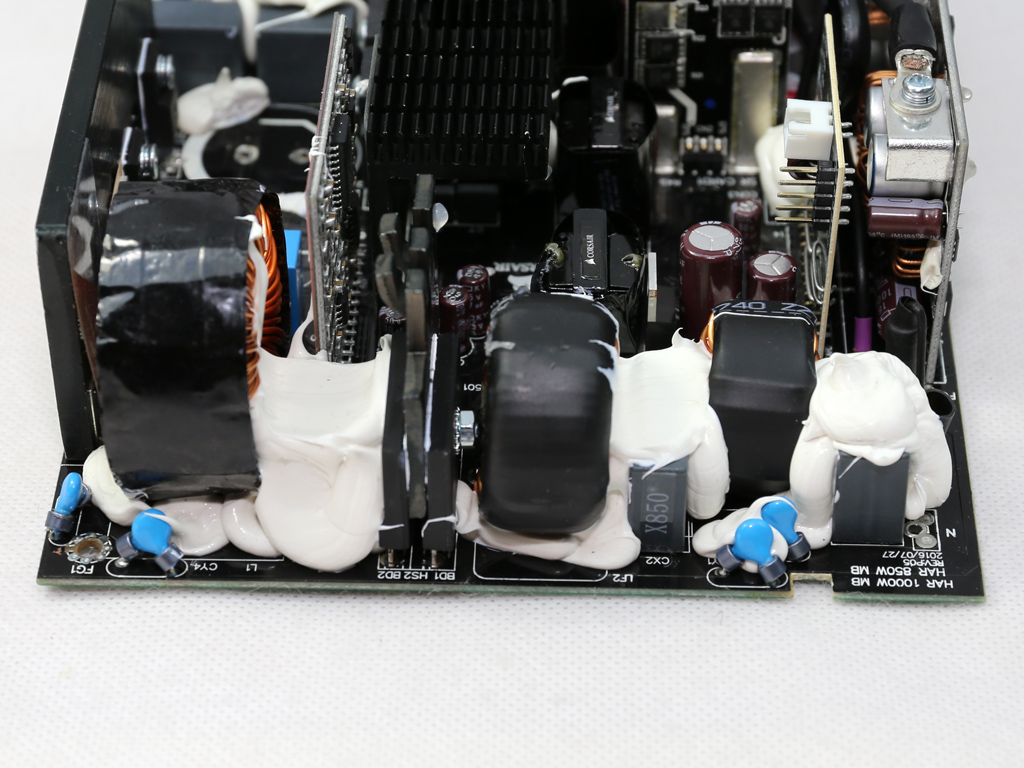

We only find a pair of Y caps at the AC receptacle. The transient filter's other parts are on the main PCB, including four Y and two X caps, two CM chokes, and an MOV. Corsair uses tons of glue in the secondary part of the transient filtering stage to ensure you don't encounter coil whine issues.
Similar to the HX1000, there is an NTC thermistor for protecting against large inrush currents. It's supported by a bypass relay.
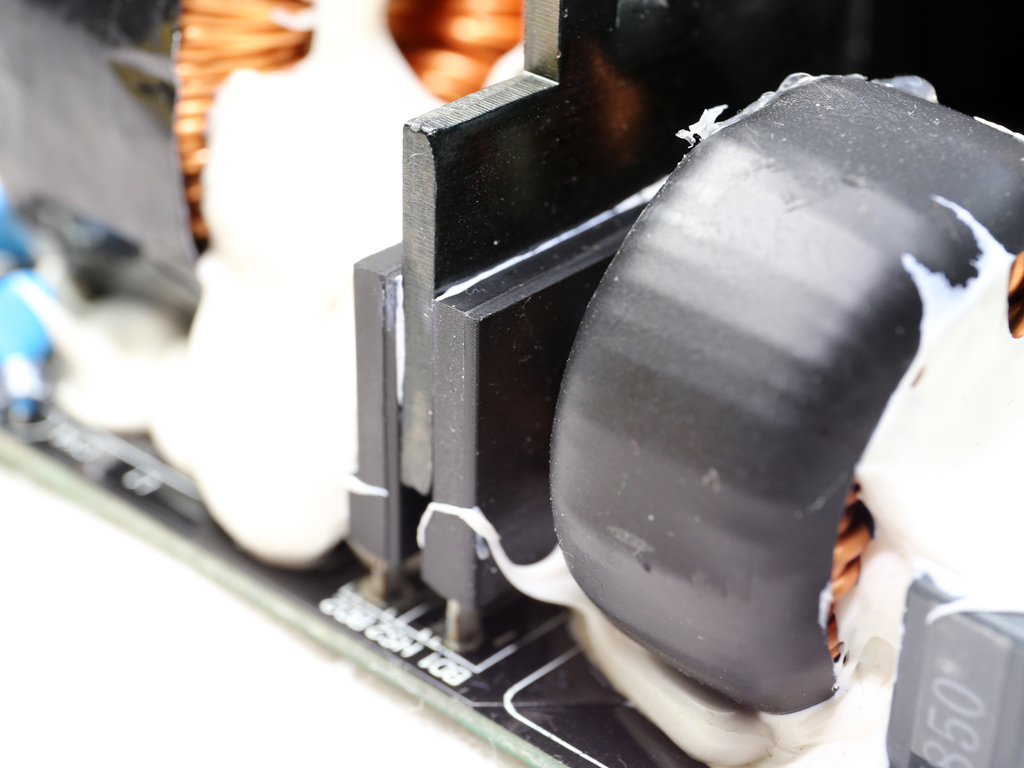
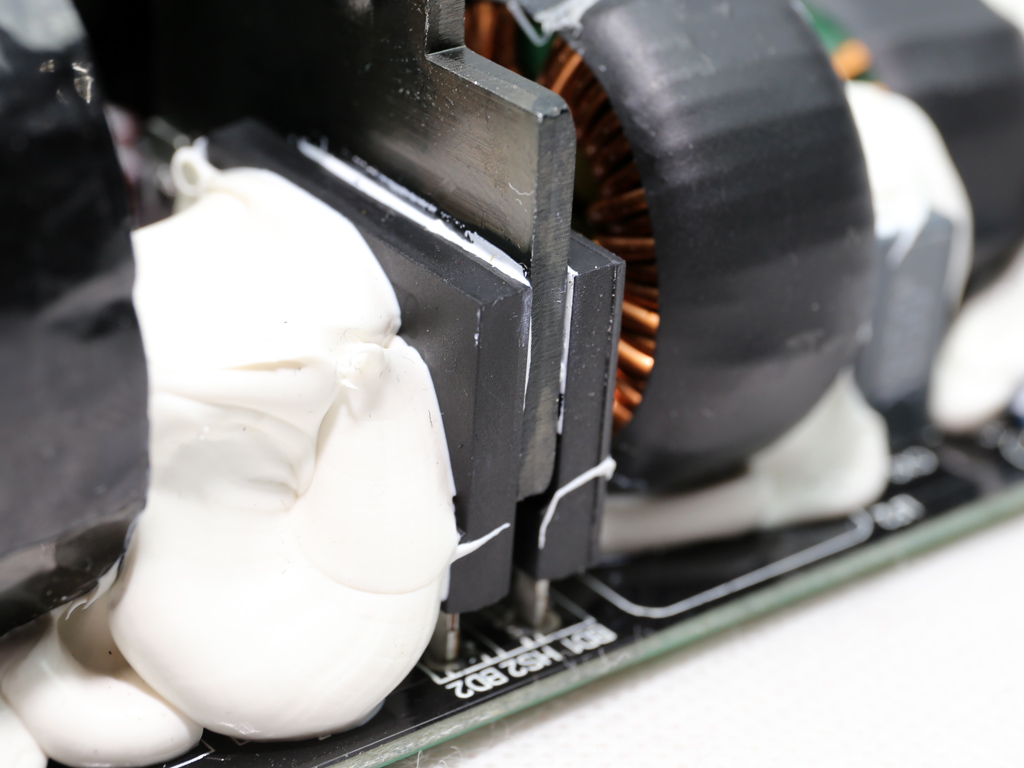
Two bridge rectifiers (Vishay LVB2560) are bolted onto a dedicated heat sink. Right next to them, the PFC input capacitor is totally covered in glue to minimize electronic noise.



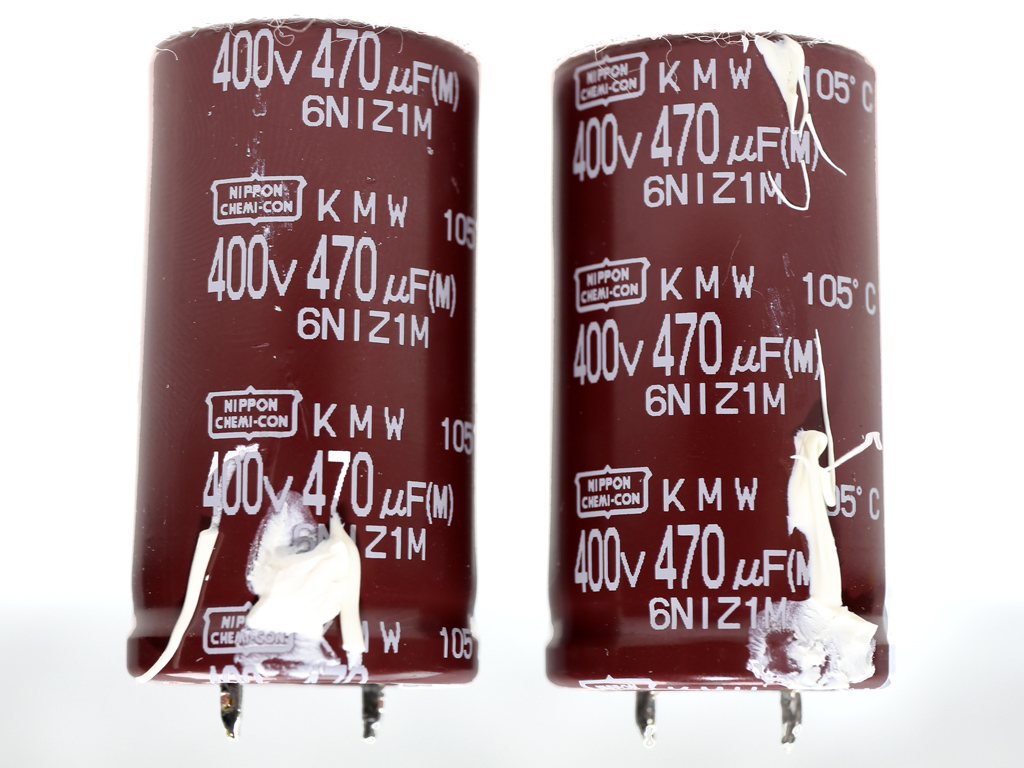
We find two Infineon IPZ60R125P6 FETs and a CREE C3D10060A boost diode in the APFC converter. The bulk caps are provided by Chemi-Con, and their combined 940uF capacity is large enough to meet the demands of a 850W PSU.
The primary FETs, two Vishay SIHG30N60Es, are configured into a half-bridge topology. An LLC resonant converter is also used for reducing switching losses.
Get Tom's Hardware's best news and in-depth reviews, straight to your inbox.

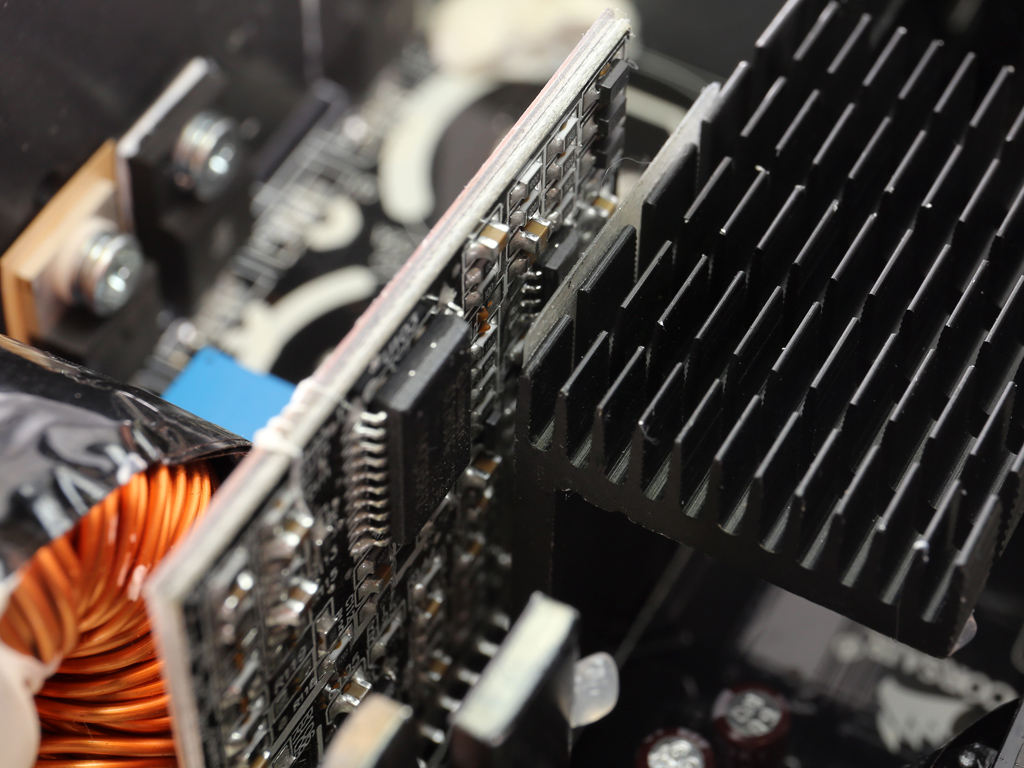
A vertical board hosts the LLC resonant controller, an Infineon ICE2HS01G IC. On the same board are also the APFC controller, an Infineon ICE3PCS01G, and a CM03X Green PFC controller.
Two vertical boards on the secondary side host eight Infineon BSC014N04LS FETs. The HX1000 is equipped with 10 FETs of the same type.
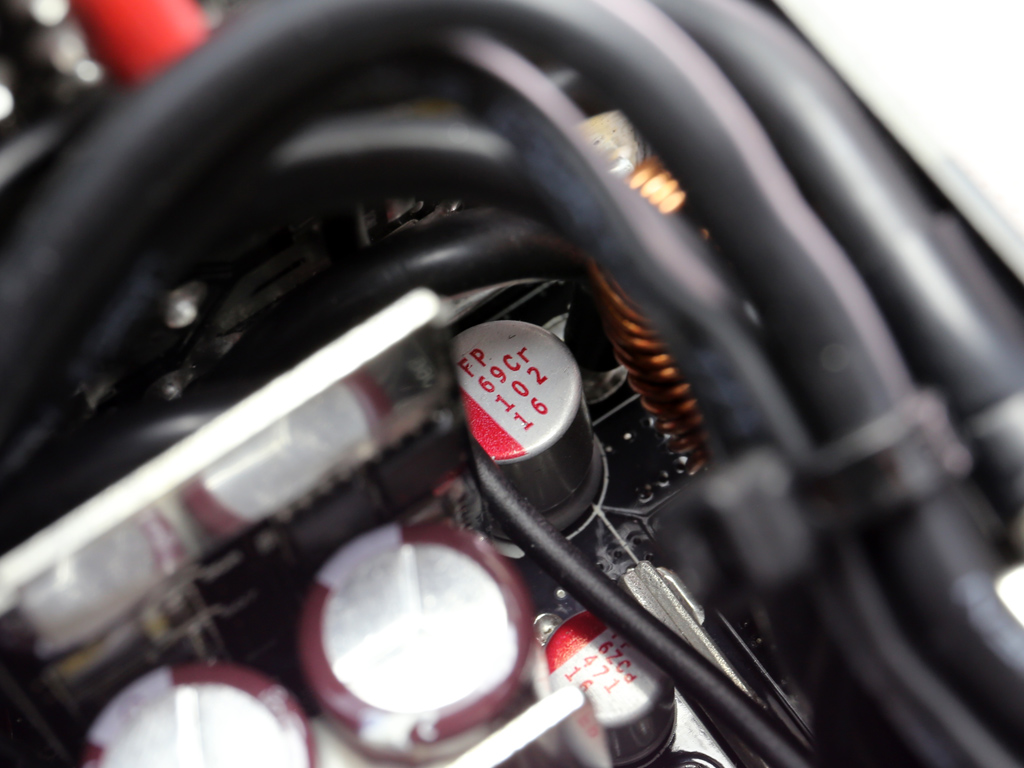
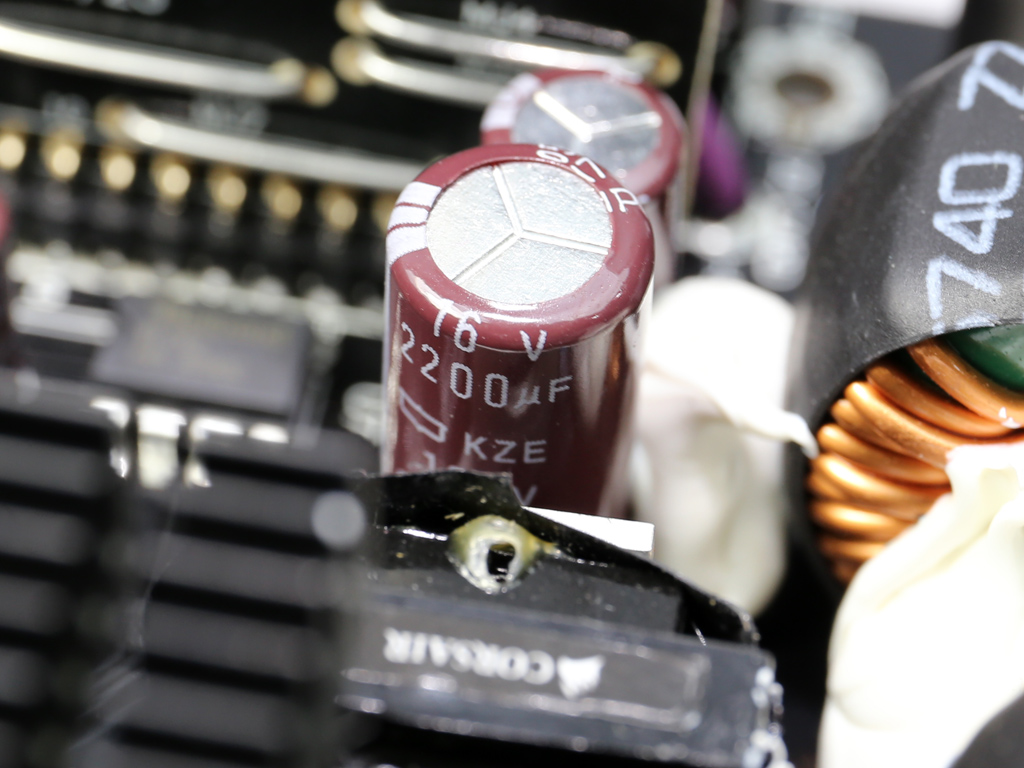
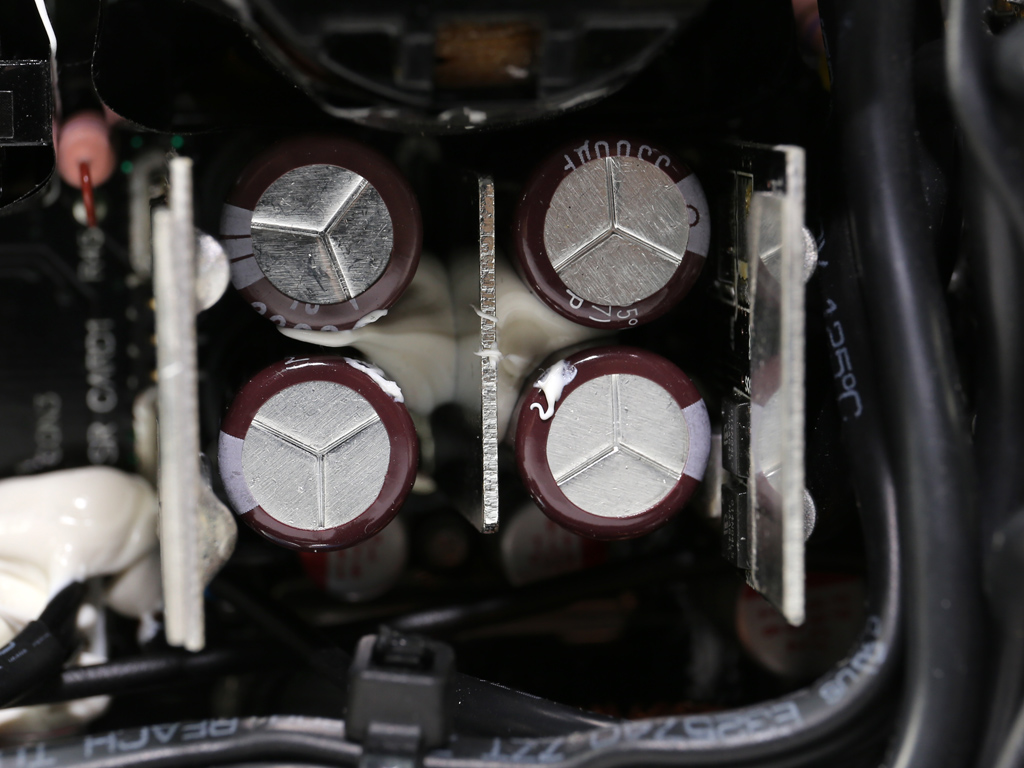
The electrolytic filtering caps on the secondary side are provided by Chemi-Con, and they belong to the company's KZE and KY lines. A number of polymer caps are also used for filtering purposes. Those are provided by Chemi-Con and FPCAP. We should note that the KZE electrolytic caps are on the bottom of Chemi-Con's portfolio. However, the higher-quality KY caps (along with the polymer ones) handle much of the ripple filtering.
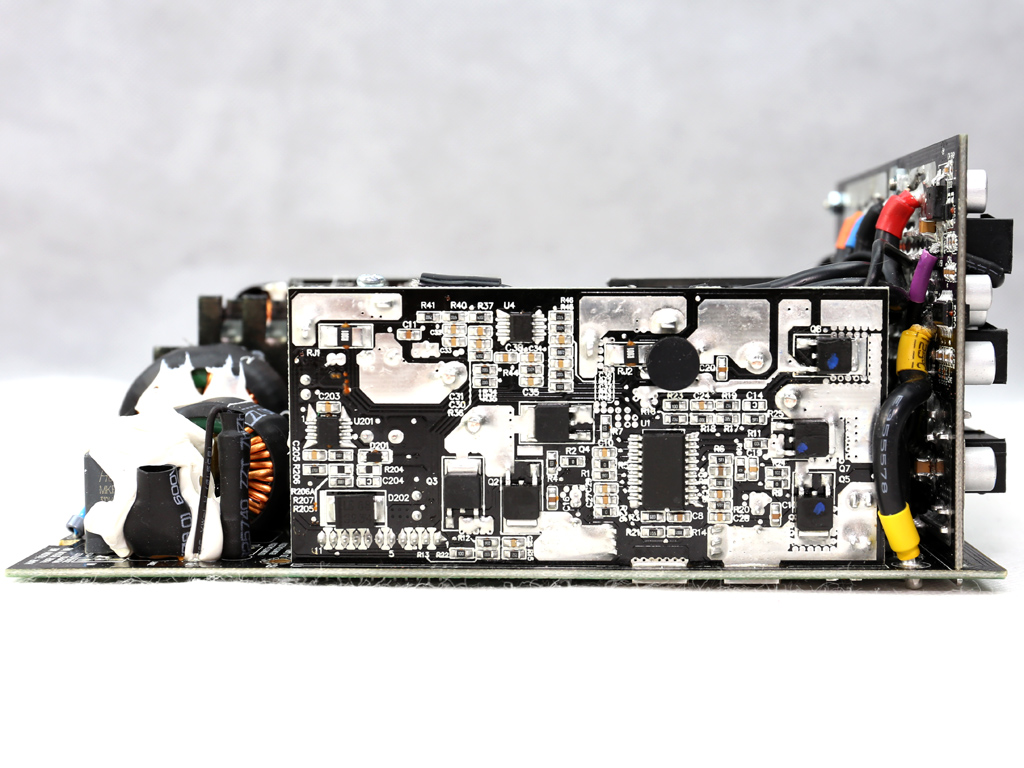


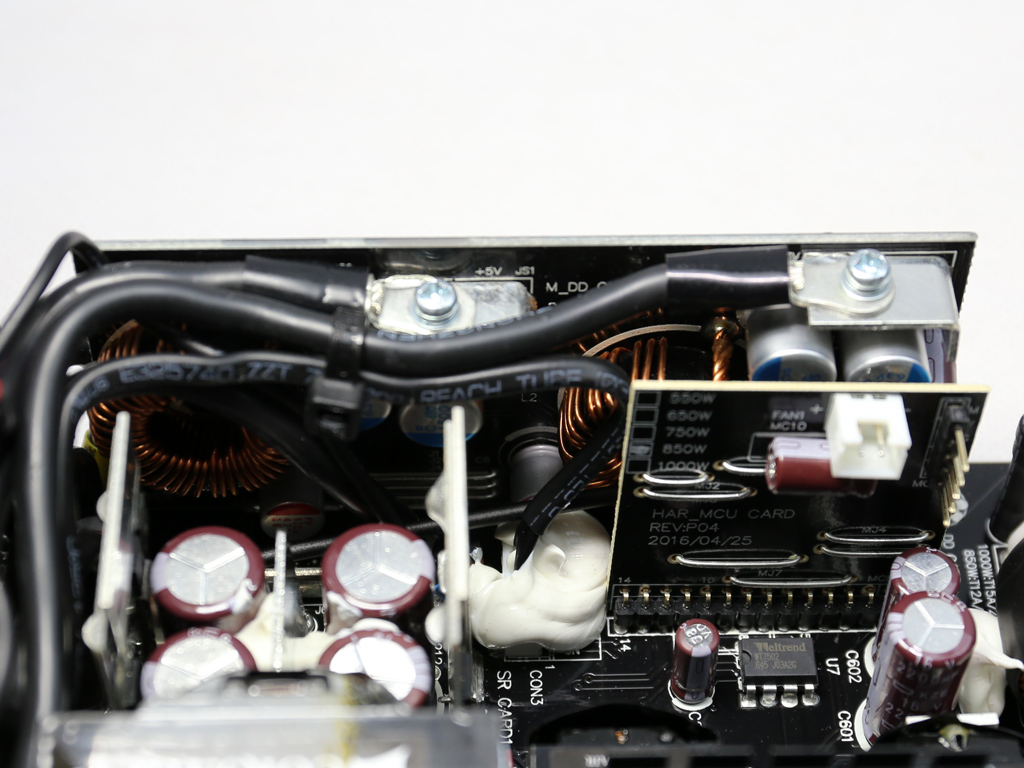
The DC-DC converters use six Ubiq QM3004D FETs in total, and the common PWM controller is an Anpec APW7159C. The same parts are used in the HX1000.
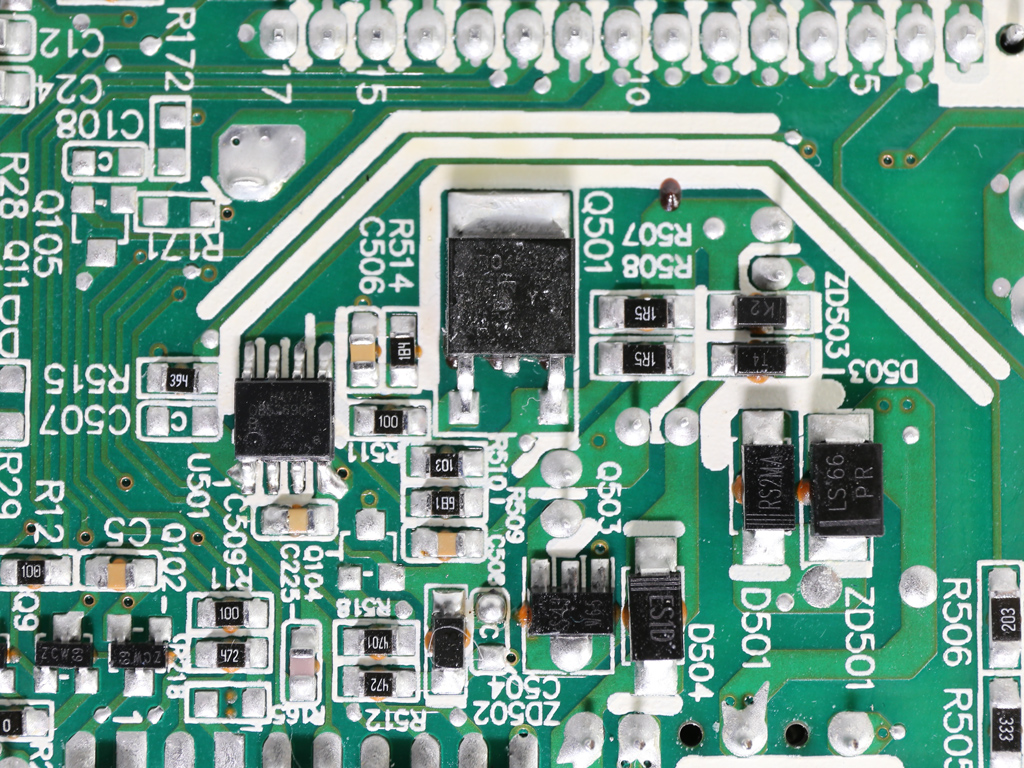

Again, similar to the HX1000, this PSU's 5VSB rail is regulated by a combination of a M03N65D FET and a MBRU2045CT SBR. The standby PWM controller is installed on the main PCB and it's an On-Bright OB5269CP.

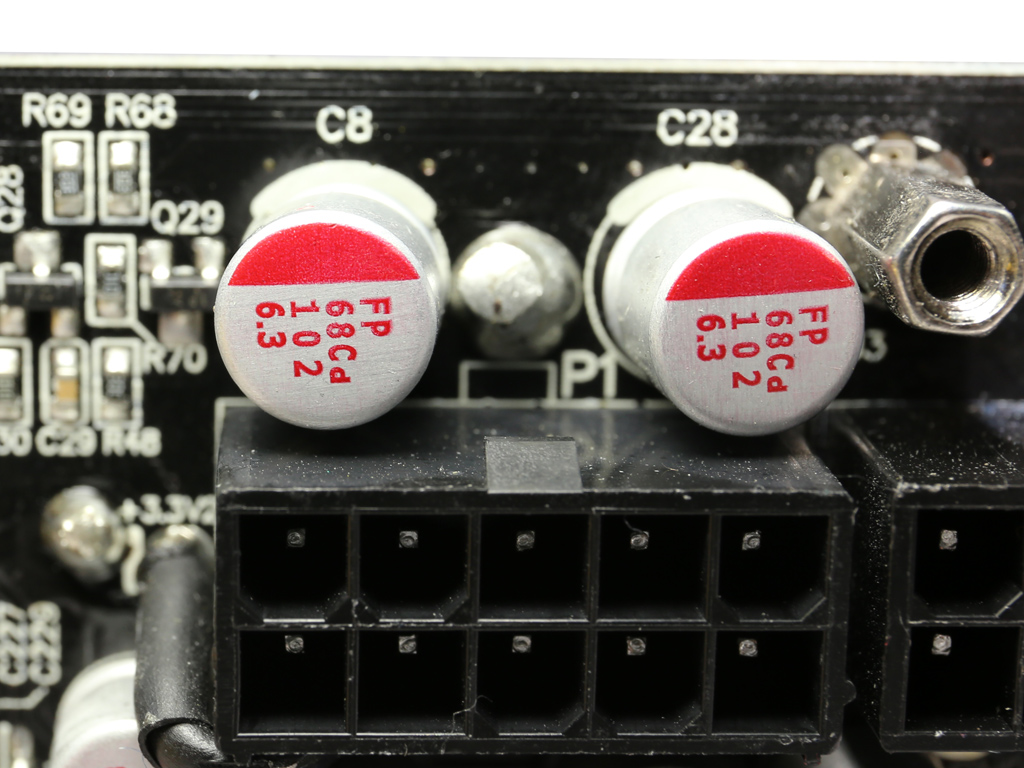


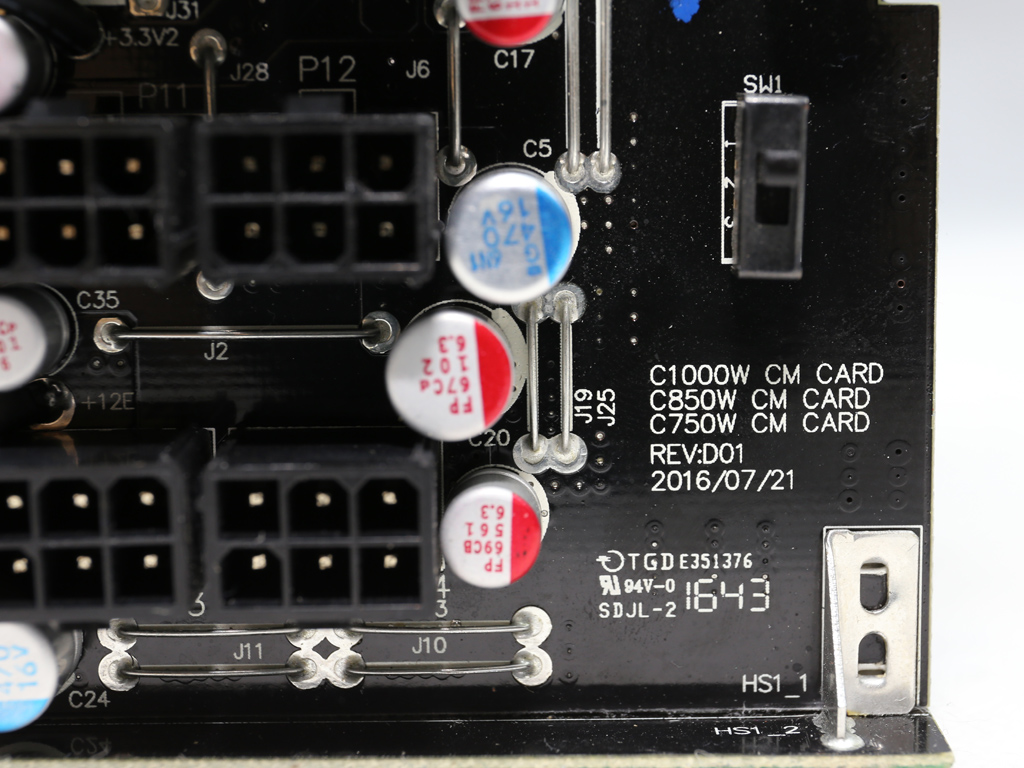

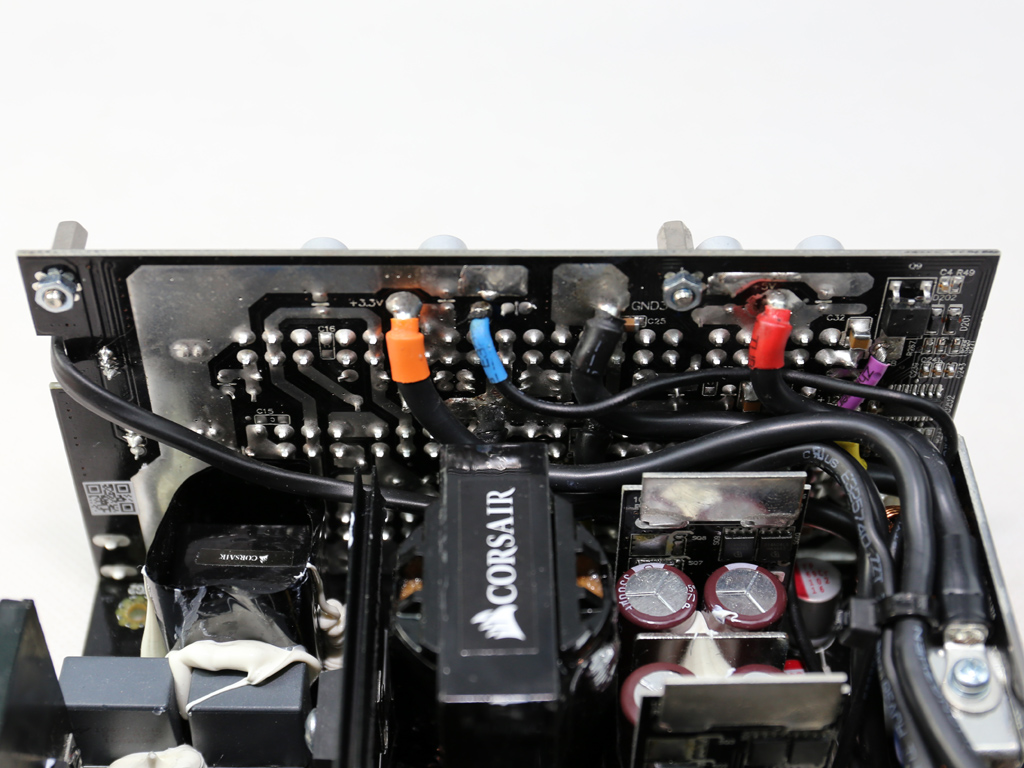

A number of FPCAP polymer caps are installed on the modular board's front side. Around back, we find a M3004D FET, which most likely is used by the 5VSB rail.
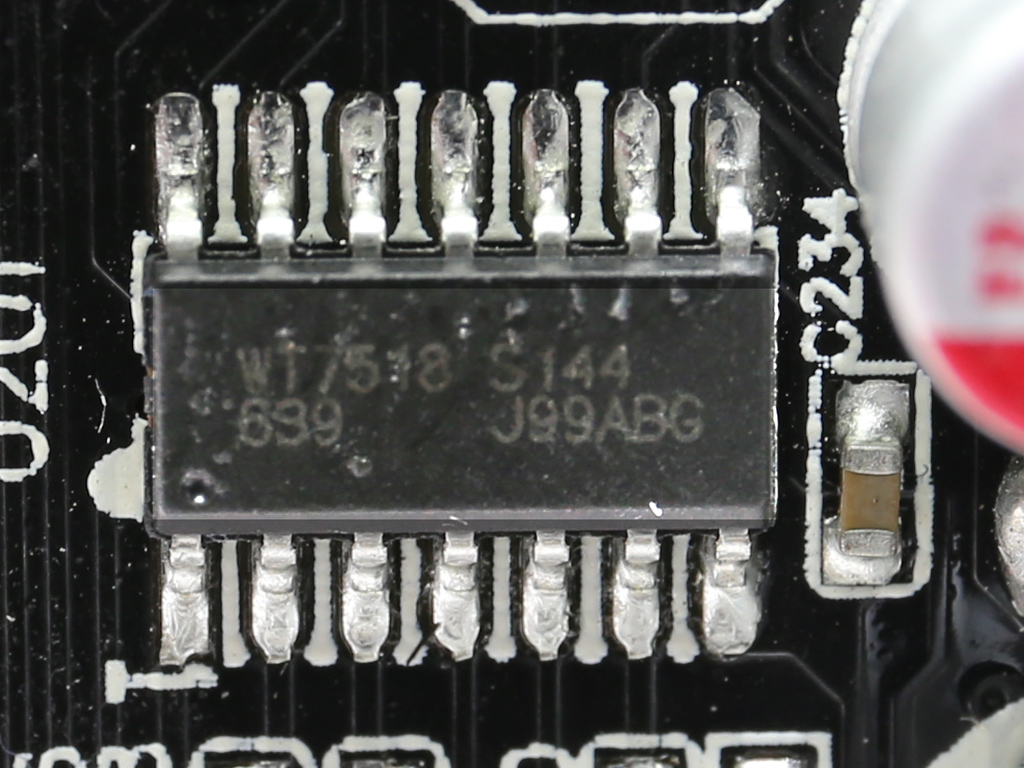
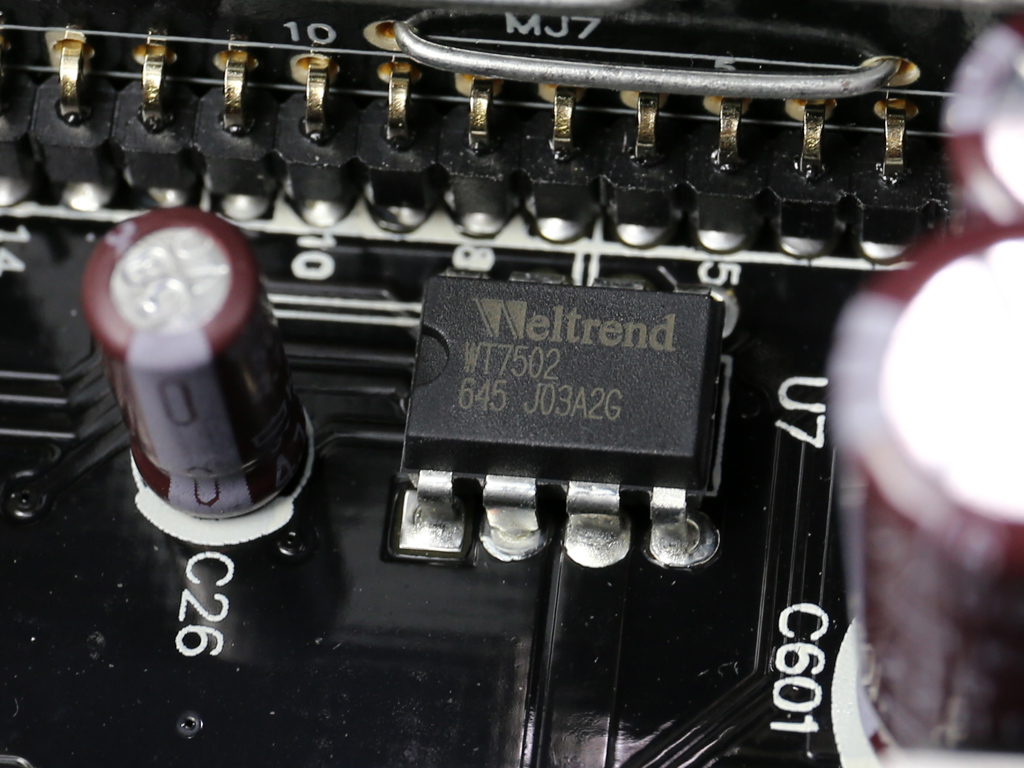
Two Weltrend WT7518s, along with a WT7502, handle the PSU's protection features. Both WT7518 ICs are installed on the modular board.
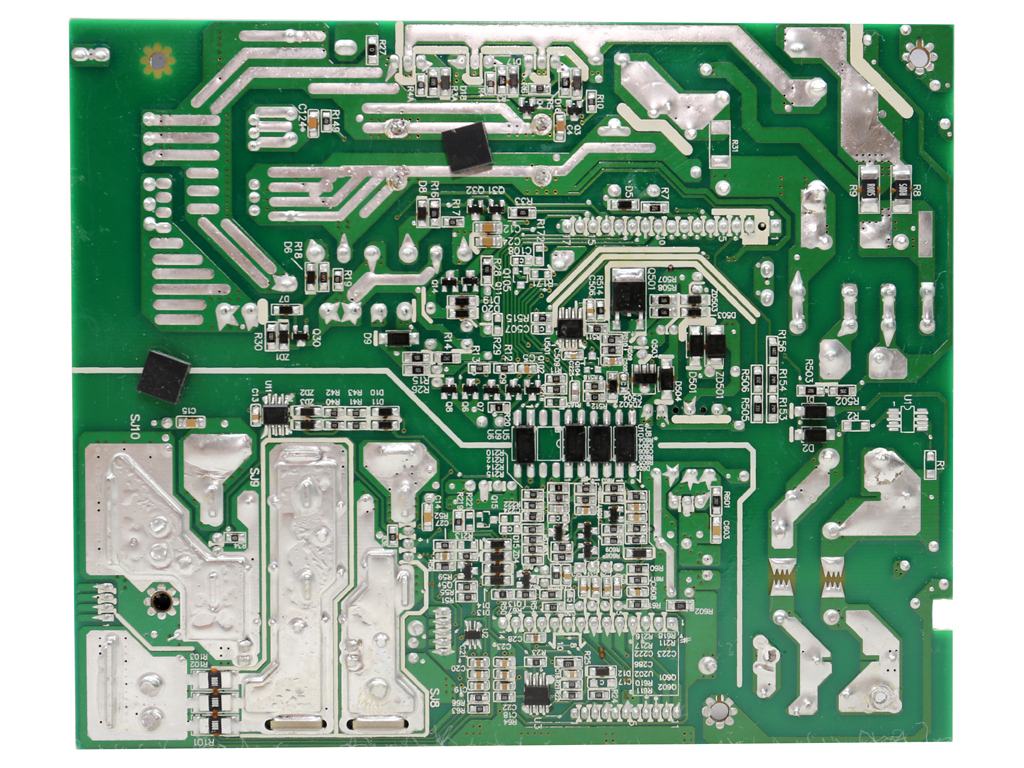
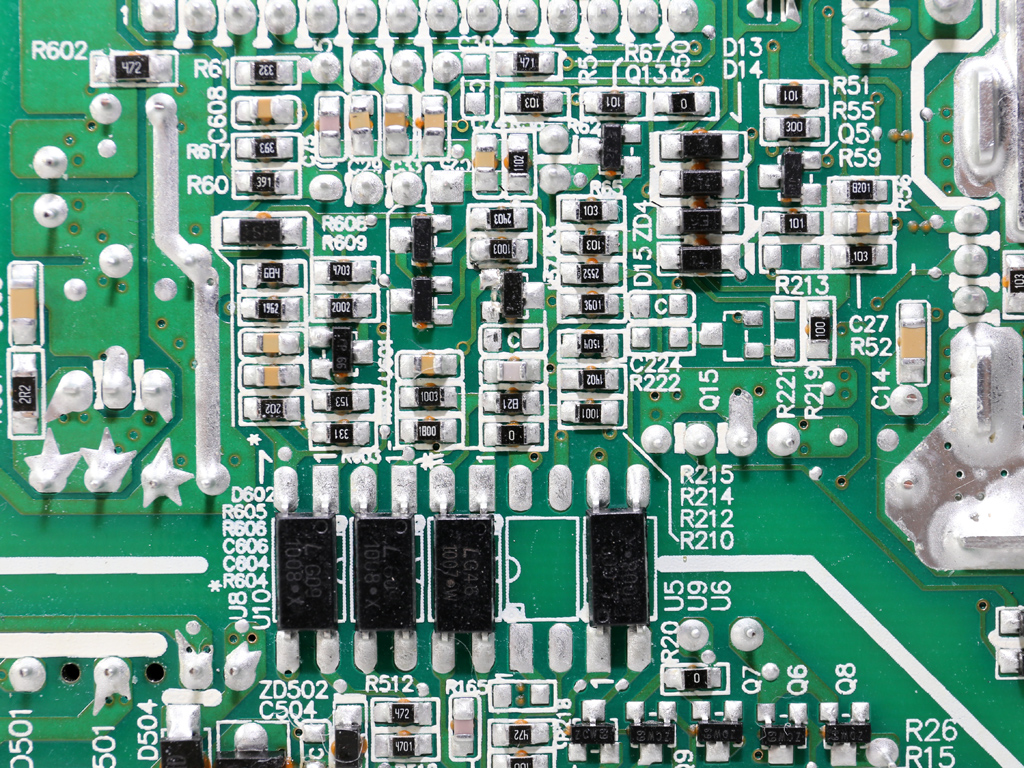
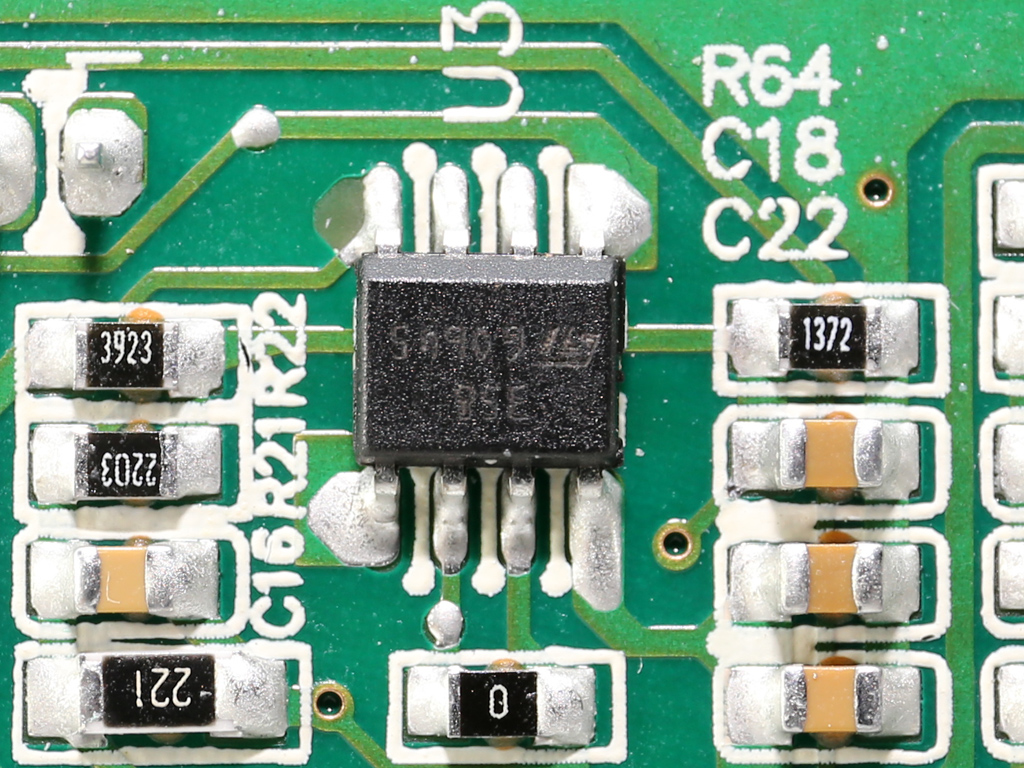
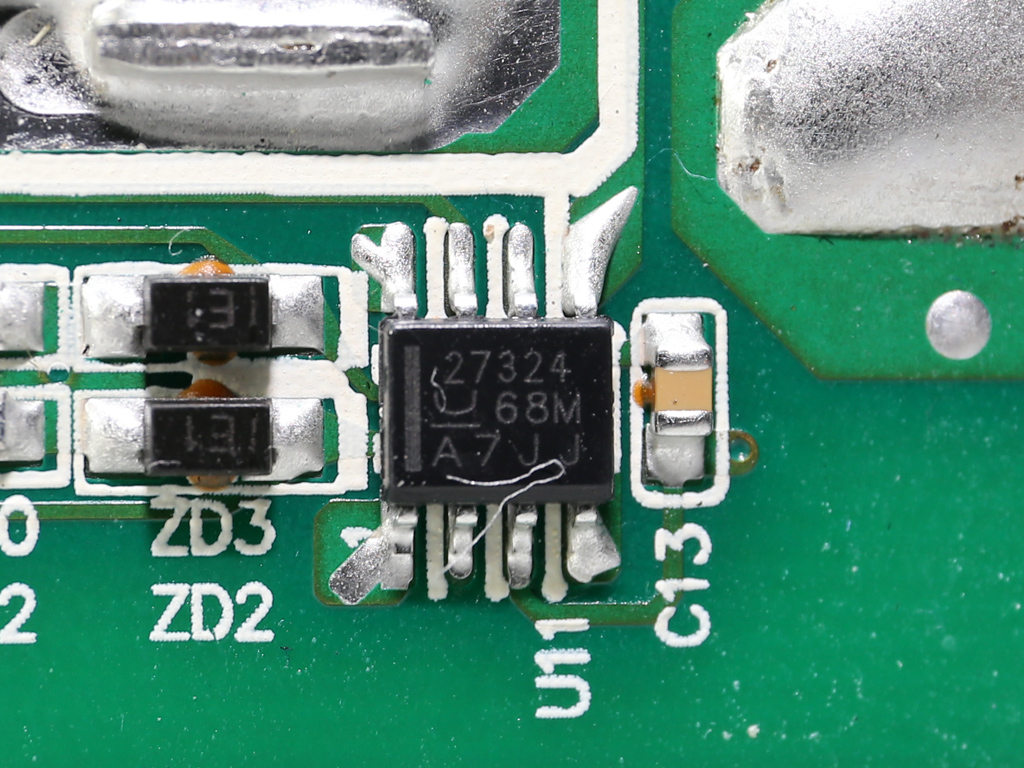
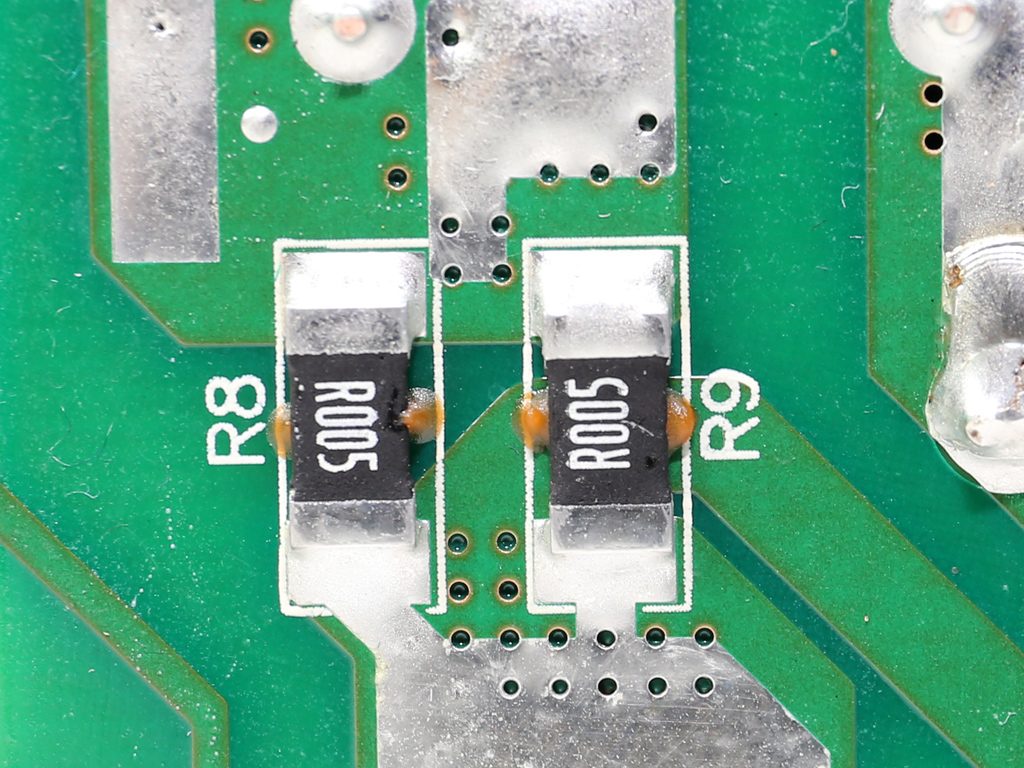


The soldering looks pretty good. CWT and Corsair maintain solid build quality in their top offerings.
A Microchip PIC16F1503 is used to control fan speed. This allows the platform to adjust its fan profile easier.
The HX850 uses a NR135P fan (135mm, 12V, 0.22A). Thanks to its FDB bearing, it should last a long time. In general, this is a slow-spinning fan that doesn't make much noise, even at full speed.
MORE: Best Power Supplies
MORE: How We Test Power Supplies
MORE: All Power Supply Content
Current page: Teardown & Component Analysis
Prev Page Packaging, Contents, Exterior & Cabling Next Page Load Regulation, Hold-Up Time & Inrush Current
Aris Mpitziopoulos is a contributing editor at Tom's Hardware, covering PSUs.
-
derekullo Would it be possible to do a comparison between the Corsair HX850 and the AX860?Reply
All digital sounds nice on paper, but how does it translate into power supply performance?
Does the extra $12 for the AX860 give you a quantifiable difference between them?
And if the AX860 does turn out to be superior in some way then why does the HX850 even exist in the first place?
Corsair AX860 $181.99
https://www.newegg.com/Product/Product.aspx?item=N82E16817139041
Corsair HX850 $169.99
https://www.newegg.com/Product/Product.aspx?Item=N82E16817139083
I remember back in 2002 I blew my power supply while overclocking and playing Tron 2.0 .
(The power supply didn't take out anything, just had to buy a new one.)
Ever since then I've always used the highest priced AX line, with the rationale of never going cheap on my power supply again.
(And being more conservative with my overclocks) -
Aris_Mp The AX860i has 1.42% higher overall performance score than the HX850 and the AX860 is very close to the AX860i. I would say that the performance of the AX860 and the HX850 is really close, however the second is much more silent.Reply -
ElectrO_90 The first paragraph talks about the HX850i and the new cables in this HX850.Reply
Where are the comparisons between the 2?
Why even mention it, if you aren't going to show how much better the HX850 cables are, if at all?
